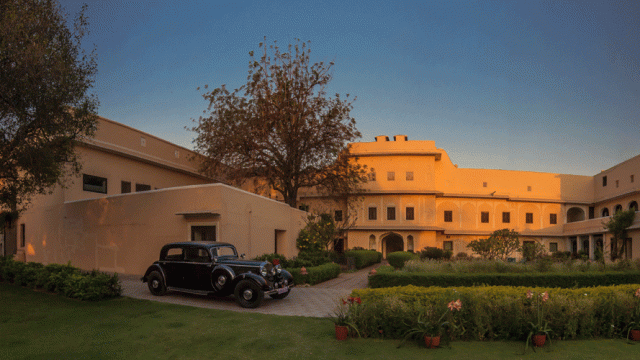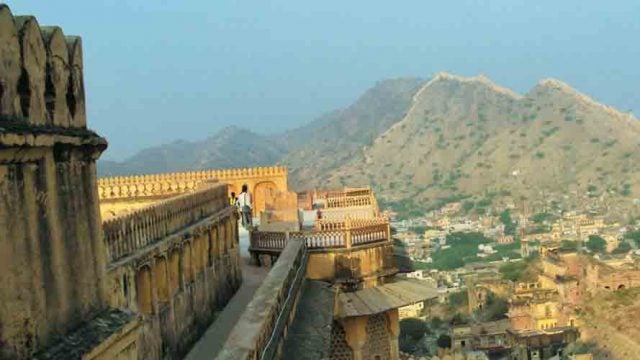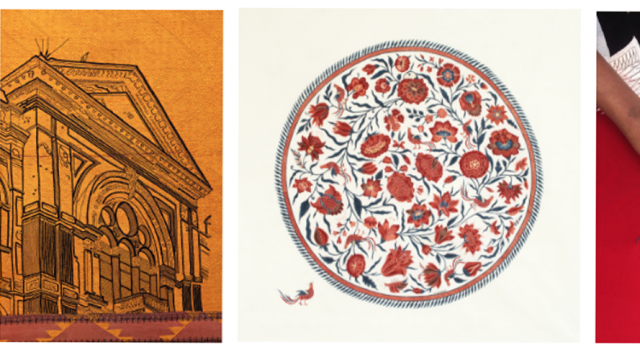Vivian is delighted that she has got herself a ring with a star ruby, unique to Rajasthan.
It helps that when the views come to us through those glorious windows, we can lie full-length alongside on our sprawl-friendly beds. In fact, when we do need to turn our heads and look inside, the view is just as good. My room is a positive symphony of deep blue.
Walls glow an exquisite sapphire (or exquisite ruby, or pearl, as the case — and the name of the room — may be). Atmospheric lighting does its bit. The bedspreads are a dull-gold embellished silken treat. The chairs and table and wall paintings have a satisfyingly ‘antique’ look. Even the bathrooms (apart from a glass-chic shower cubicle and a glass basin with a Cinderella’s-slipper air about it) are stuffed with those necessities of life — delicately scented towels that are positively voluptuous. The eight cushions and pillows in the room too go from comfortable and plump to fat. I have too much dignity to bounce on the bed. Besides, I have to move on to the next several-course meal.
Royal Rajasthan on Wheels can be many things to many people (most of them non-Indian tourists), such as a romantic 25th anniversary package, an at-a-glance look at the best of Rajasthan, or a rare luxury splurge. But its appeal really lies in the totality of the package. For admittedly a substantial sum of money, you can hand yourself over to the professional and experienced hands of the Rajasthan Tourism department and then can stop thinking-planning-worrying for seven days, except perhaps to puzzle over the colour of your souvenir turban. You are fed — and how. You are taken around according to a well-thought-out itinerary and given ample and reliable opportunities to shop. As my friend, the filmmaker from New Zealand said, India can be chaotic, and though the chaos is magnificent, it is a relief to move about feeling secure and contained with no bookings to do, have someone to turn to for advice and help all the time, and have a cosy nest to return to every evening. Since the nest goes with you, no travel worries either.
All this in a stunner of a train, all silks and service. Every time you alight there are benign hands to help you down. Every time you enter a town or a hotel, elephants trumpet and shehnais sing and pretty girls in pink saris garland you and look genuinely happy to see you. The managers’ and attendants’ care for detail is immaculate: you are well supplied with chilled drinking water all day and get adequate restroom stops (or warnings, “please have only a small cup of tea because in the safari there’ll be no bathroom for one-and-a-half hours — only the tiger and you”). Practical tips on how to deal with hawkers, how much to pay and for what are always forthcoming.
And then they take you for a ride par excellence. This tour, train ride apart, has an elephant ride (Amber fort), a camel ride (Jaisalmer sand dunes), a boat ride (Udaipur’s Lake Pichola), a jeep ride (Ranthambhore National Park) and a rickshaw ride (Bharatpur sanctuary). From all of which you come back to lambent suites and ‘khidmatgars’. “Maharaja, Maharaja,” say the foreigners happily pointing to their bright red turbans. “Maharaja,” agrees the khidmatgar, smiling like an indulgent father.
The roster call of places to see comes with its own glamour. Jaipur, Chittor, Udaipur, Jaisalmer, Jodhpur among others, not to mention that teardrop on the cheek of travel writers — the Taj Mahal.
Mr O.P., unflappably good humoured and “24 hours at your service,” the experienced manager from many Palace on Wheels journeys, grants that it’s a full day in Jaipur, the first day of our tour. Elephants with painted ears and trunks come to salaam us a welcome. The air-conditioned coaches move around Sawai Jai Singh’s old city with the guide pointing out the grid pattern layout, the width of the road and the unmissable pinkness of it all. But this is not the kind of tour to be turned over to the mercies of crowds at Johari Bazaar or Bari Chopar. We see the Hawa Mahal, admire the dancing cobra and move on to Amber fort. “Here we will go up on an elephant. You know how you have to climb the elephant? No, not done before? Put your feet on its trunk and pull yourself up by its ears.” But at this point even the guide, who manages his jokes with remarkable spontaneity, cannot keep a straight face. As it turns out, to Gamze’s relief, we don’t have to do exactly that. And a bunch of giggly, some hysterical, tourists sway and bump their way to the grand fort.
They get their money’s worth. There’s a Sheesh Mahal photograph-worthy for even jaded India hands; and a door that, while opening, makes the warning sound exactly like a roaring tiger and then exactly like a trumpeting elephant; there are the gigantic cooking utensils and then the views of the city spread out below. Finally, there are your pictures of the elephant ride taken by opportunity-savvy photographers who somehow manage to find you an hour later in all that crowd and sell you the brilliantly vivid prints with floral borders. These are bought for the guide-advised price of Rs 50 — “They will say Rs 200 in the fort but when you have entered the bus, they will come down to Rs 50.”
After which the entire entourage of hats, caps, sunglasses and a newly bought patchwork parasol drive off to the City palace for lunch. In a private dining hall of the maharaja’s palace, if you please. Peacocks amble on the lawns and live sitar plays as we tuck into our mushroom canapés, penne in arrabiata sauce, lal maas, chicken in red wine and so on. The gulab jamuns are widely appreciated, creating an inter-continental consensus. Gamze is in love with the boondi ka raita.
The approved showrooms of jewellery, carpets and handlooms are satisfying not just because it’s possible to shop (and even better to try on the stuff and have lively discussions about it) but also because small demos are given about precious stones and their polishing, hand-block printing and carpet-weaving. The painstaking process of hand-knotting a carpet evokes awe. And that the carpets are burned at the back to check their authenticity; silk or wool will only singe, not burn or melt. (“Today you have got roasted chicken and roasted carpets.”)
The City Palace and the quirks of the maharajas provide much amusement in the second half: the huge Sawai Madho Singh and his giant angarkha, the equally huge silver urns in which he carried his gangajal to England (he wouldn’t drink any other water), the beauty of Gayatri Devi, the polo ball with a candle inside for a night-time game… It’s an exhausted but admiring gang that bids adieu to the Jantar Mantar and sinks appreciatively into the open-air dinner arrangements of the Taj group-run Jai Mahal Palace, its open-air candlelit beauty, its wine and fire-eating performers. We wouldn’t be able to sit like this where I come from, says a New Zealander soaking in the lovely autumn evening. I am eating too much, says his wife, but the Americans are eating much more, they giggle. They do do you well, agree the Americans.
“You have been very patient today but I promise, from tomorrow, you will say ‘Mr O.P. this is very good’. From tomorrow, it will all be, sightseeing-relaxing, relaxing-sightseeing. Only tomorrow morning, you have to wake up at six….” The groans that follow are over soon in the realisation that the early morning is to be able to, hopefully, catch sight of a tiger at Ranthambhore. And that the safari will be over before breakfast, with the day journey to Chittor giving ample time to curl up on the train and see the sights of the dry Jaipur region give way to the lush, hilly southern tracts.
There’s Chittor to come, with Son-et-Lumiere tales of mass jauhars and valour. There’s Udaipur to come; her lakes have good water this year, and I tell everyone how this means those dreamy lake palaces will be seemingly afloat on the waters of Lake Pichola. There’s the Mehrangarh Fort to come — Aldous Huxley called the miniature-painting-like view of the city from here a sight akin to what the gods had at Olympus. There’s Jaisalmer too — with its golden yellow doll’s house of a fort and those magical sand dunes — and I’m nearly willing to get into an argument about how that is the crown of the trip and not the Taj. And haunting desert voices and luscious colours and winter sun on glasswork skirts will accompany us throughout. And perhaps they’ll serve the chicken stroganoff again.
The information
Royal Rajasthan on Wheels is run by RTDC, the same folks who have been running the Palace on Wheels for years. It presently offers a seven-night luxury train tour of Rajasthan (there are plans for a more extensive itinerary, taking in Khajuraho and Varanasi). Compared to the Palace on Wheels, the rooms are bigger, the décor more luxurious and the train carries fewer passengers. This ensures a more exclusive and relaxed experience. The train departs from Safdarjang Railway Station, Delhi, every Sunday evening from October to March. It’s a Sunday-to Sunday tour. It is possible to do smaller itineraries on the tour, with a minimum of three nights.
The itinerary Day 1: Departure from Delhi (evening). Day 2: Jaipur. Day 3: Ranthambhore National Park and Chittorgarh. Day 4: Udaipur. Day 5: Jaisalmer. Day 6: Jodhpur. Day 7: Bharatpur and Agra. Day 8: Return to Delhi (morning).
Facilities: The train comprises two super deluxe rooms and 39 double deluxe saloons. The total capacity is 82 passengers. There are two restaurant-cum-lounge cars, with well-stocked bars. There’s a kitchen car, two staff cars and two power cars. The super deluxe rooms have double beds, a sitting area and a wardrobe. The deluxe rooms are twin-bedded, with a small table, two chairs and a wardrobe. Every car has a 24-hour attendant, and while there is no room service for meals, you can summon tea/coffee, water, biscuits, fruit, etc in the room.
Tariff: Super Deluxe: $1,600 (per room per night). Deluxe: $590 (per person per night on twin-sharing basis)/$825 (per person per night for single occupancy). Taxes are extra. The tariff is inclusive of cost of travel, accommodation, all meals, sightseeing tours, entrance fee (excluding video camera fee where charged) and entertainment. Tariff does not include liquor and laundry.
Contact: Rajasthan Tourism Development Corporation, 011-23386069, 23383837, [email protected], www.rtdc.in
luxury train
Palace On Wheels
Rajasthan
Leave a Reply
You must be logged in to post a comment.





